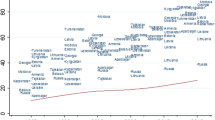Abstract
The number of Brazilian publications in the Institute for Scientific Information database, ISI, increased significantly in the last 20 years, comprising more than 1 percent of the database in the last two years. The relationship between size and recognition of Brazilian science, estimated by number of ISI-indexed publications, p, and citations, c, obeyed a power law, c = k pn. The value of n, a known indicator of such relationship was 1.42 ± 0.04, significantly higher than that found for the whole set of ISI-indexed world publications. The recent growth of Brazilian publication was not solely due to international collaboration, since over the last six years international collaboration, estimated as the percentage of Brazilian publications having at least one foreign address, reached a constant value of ca. 30%. International collaboration increased the impact of Brazilian publications. Although the most frequent collaborating countries are those that produce the largest percentage of world"s science, Brazilian collaboration with Argentina and Chile exhibit impacts comparable to the major science producers.
Similar content being viewed by others
References
J. S. Katz, Scale-independent indicators and research evaluation, Science and Public Policy 27 (2000) 1-23.
J. S. Katz, The self-similar science system, Research Policy 28 (1999) 501-517.
J. S. Katz, D. Hicks, How much is a collaboration worth? A calibrated bibliometric model. Proceedings on the 6 th Conference of the International Society for Scientometrics and Informetrics, Jerusalem, Israel, June 16-19 (1999) pp. 163-175.
F. Narin, K. Stevens, E. S. Whitlow, Scientific cooperation in Europe and the citation of multinationally authored papers, Scientometrics 21 (1991) 313-323.
W. GlÄnzel, A. Schubert, Double effect = double impact? A critical view at international co-authorship in chemistry, Scientometrics 50 (2001) 199-214.
A. F. J. Van Raan, The influence of international collaboration on the impact of research results, Scientometrics 42 (1998) 423-428.
D. de B. Beaver, R. Rosen, Studies in scientific collaboration: Part I — the professional origins of scientific co-authorship, Scientometrics 1 (1978) 65-84.
M. Leclerc, J. Gagne, International scientific cooperation — the continentalization of science, Scientometrics 31 (1997) 253-263.
J. S. Katz, B. R. Martin, What is research collaboration? Research Policy, 26 (1997) 1-18.
J. S. Katz, Geographical proximity and scientific collaboration, Scientometrics, 31 (1994) 31-43.
W. GlÄnzel, National characteristics in international scientific co-authorship relations, Scientometrics, 51 (2001) 69-115.
J. Leta, L. de Meis, A profile of science in Brazil, Scientometrics, 35 (1996) 33-44.
C. Macilwain, Collapse of real sharpens Brazil's contrasts, Nature (supplement), 398 (1999) A16-A18.
ISI, Institute for Scientific Information — Web of Science, available for Brazilian Institutions at http://webofscience.fapesp.br/. Total world publications summed up 780,355 in 1981 and 1,166,116 in 1998 (49.4% of increase); total of Brazilian publications in the same period increased from 2,607 to 10,420 (299.7% of increase).
T. Braun, W. GlÄnzel, H. Maczelka, A. Schubert, World science in the eighties. National performance in publication output and citation impact, 1985-1989 versus 1980-1984, Scientometrics, 31 (1994) 3-30.
NSF, National Science Foundation. Science and Engineering — Indicators 2000. Available at http://www.nsf.gov/sbe/srs/stats.htm
W. GlÄnzel, A. Schubert, H. J. Czerwon, A bibliometric analysis of international scientific cooperation of the European Union (1985-1995), Scientometrics 45 (1999) 185-202.
L. de Meis, J. Leta, O perfil da ciência brasileira, Editora UFRJ, Rio de Janeiro, RJ, Brasil, 1996.
R. Meneghini, The key role of collaborative work in the growth of Brazilian science in the last ten years, Scientometrics 35 (1996) 367-373.
J. Leta, D. Lannes, L. de Meis, Human resources and scientific productivity in Brazil, Scientometrics, 41 (1998) 313-324.
L. Velho, Redes regionais de cooperação em C&T e o Mercosul, Parcerias estratégicas 10 (2001) 58-74.
S. Arunahalam, R. Srinivasan, V. Raman, International collaboration in science: participation by the Asian giants, Scientometrics, 30 (1994) 7-22.
L. Fonseca, The impact of Brazilian publications in Biochemistry and Molecular Cell Biology, Ciência e Cultura 44 (1992) 172-177.
W. Gibbs, The lost science in the third world, Scientific American 273 (1995) 76-83.
H. Vessuri, Recent strategies for adding value to scientific journals in Latin America, Scientometrics, 34 (1995) 139-161.
N. NarvÁez-Berthelemot, J. M. Russel, L. Velho, Scientific collaboration of the Mercosur countries as an indicator of Latin American regional activity, Research Evaluation 8 (1999) 83-90.
Author information
Authors and Affiliations
Rights and permissions
About this article
Cite this article
Leta, J., Chaimovich, H. Recognition and international collaboration: the Brazilian case. Scientometrics 53, 325–335 (2002). https://doi.org/10.1023/A:1014868928349
Issue Date:
DOI: https://doi.org/10.1023/A:1014868928349




